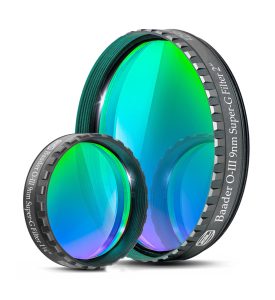The new 1.25” and 2” O-III Baader O-III Super-G filter can be used for observing and imaging gas nebulae in doubly ionized oxygen fluoresces such as planetary nebulae and supernova remnants.
 With an FWHM of only 9 nm and equipped with CMOS-optimized layering technology, it darkens the sky background and thus also stray light much better than its predecessor offering a 10 nm O-III filter.
With an FWHM of only 9 nm and equipped with CMOS-optimized layering technology, it darkens the sky background and thus also stray light much better than its predecessor offering a 10 nm O-III filter.
As the Baader team notes, “The narrower FWHM is the least part of the improvement. More important is the significantly better blocking outside the O III wavelength, as well as even steeper transmission slopes and a broad plateau in the transmission range. This filter provides a transmission of 97% for the emission line at 500.7 nm so that practically only the light of the nebula is transmitted. At the same time, this filter can be used photographically for practically any aperture ratio from f/1.8 to f/12 without causing transmission of the H-beta line. This makes the Super-G filter ideal for use in areas with high levels of light pollution as well as under dark skies. It can also be used on small telescopes, especially with large exit pupils (greater than 1-2mm) and low magnification.”
They also commented, “The Baader O-III Super-G Filter are blocked over the entire visual spectrum – but also over the entire sensitivity range of modern CMOS chips. This eliminates the irritating colored halos that can often be seen at the important O-III sources in O-III filters with less complex coating technology.”
The filter has the same thickness as the mounted Baader LRGB filters. This makes it suitable for use as a “Super-G filter”: In the transmission window of the normal green filter (490-580nm) there are no other emission lines apart from OIII, H-Beta at 486 nm is covered by the RGB blue filter. When using the 9 nm O-III filter instead of the RGB green filter, emission nebulae are therefore much more emphasized, while the stars appear weaker.
The Baader O-III Super-G Filter also performs for photographic use on all telescopes, especially with a DSLR or an astronomical OSC color camera. It offers all the advantages of CMOS-optimized Baader filters including incorporating Baader Reflexblocker coating against reflections, plano-optical polishing and non-ageing Life-Coat coating. For monochrome cameras, Baader recommends the even tighter narrowband (6.5 nm) and ultra-narrowband (4 nm) filters, which are available in versions adapted for different aperture ratios. Preshifting at aperture ratios faster than f/4 is not necessary for this comparatively broadband 9nm filter, it can be used at all aperture ratios.
You can learn more about the Baader O-III Super-G Filter here.
And to make it easier for you to get the most extensive news, articles and reviews that are only available in the magazine pages of Astronomy Technology Today, we are offering a 1-year magazine subscription for only $6! Or, for an even better deal, we are offering 2 years for only $9. Click here to get these deals which only will be available for a very limited time. You can also check out a free sample issue here.
The sun is more active than it has been in years! If you’d like to learn more the technology behind solar observing, solar imaging and more, you can check out our free publication, “The Definitive Guide to Viewing and Imaging the Sun”. You don’t have to sign up or provide any information, simply click here and enjoy reading!

